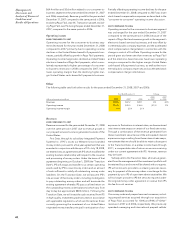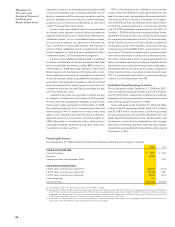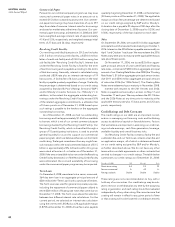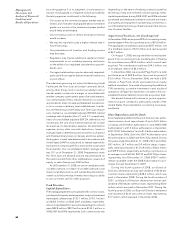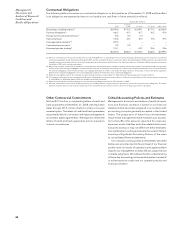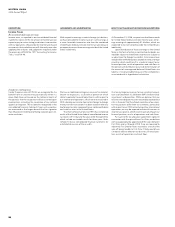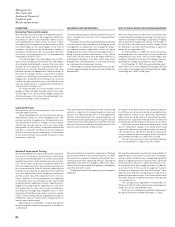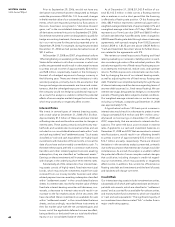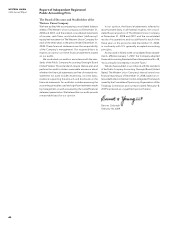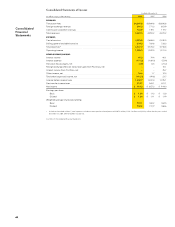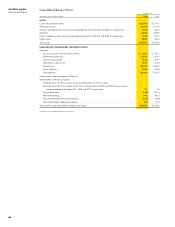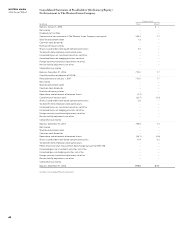Western Union 2008 Annual Report Download - page 41
Download and view the complete annual report
Please find page 41 of the 2008 Western Union annual report below. You can navigate through the pages in the report by either clicking on the pages listed below, or by using the keyword search tool below to find specific information within the annual report.3939
Management’s
Discussion and
Analysis of Financial
Condition and
Results of Operations
New Accounting Pronouncements
In March 2008, the FASB issued SFAS No. 161, “Disclosures
about Derivative Instruments and Hedging Activities, an
amendment of SFAS No. 133” (“SFAS No. 161”). SFAS
No. 161 is required for financial statements issued for fis-
cal years and interim periods beginning after November
15, 2008 and early adoption is permitted. SFAS No. 161
requires additional disclosures about how and why we
use derivatives, how derivatives and related hedged items
are accounted for under SFAS No. 133, and how deriva-
tives and related hedged items affect our financial posi-
tion, results of operations, and cash flows. Our derivative
disclosures already incorporate many of the provisions
outlined in SFAS No. 161. Accordingly, we do not expect
that the adoption of this pronouncement in 2009 will have
a significant impact on our financial position, results of
operations and cash flows.
In December 2007, the FASB issued SFAS No.
141R, “Business Combinations” (“SFAS No. 141R”). This
statement establishes a framework to disclose and
account for business combinations. The adoption of the
requirements of SFAS No. 141R applies prospectively to
business combinations for which the acquisition date is on
or after fiscal years beginning after December 15, 2008
and may not be early adopted. The impact of the adop-
tion of SFAS No. 141R will depend upon the nature and
terms of business combinations that we consummate on
or after January 1, 2009.
In December 2007, the FASB issued SFAS No. 160,
“Noncontrolling Interests in Consolidated Financial
Statements—an amendment of ARB No. 51” (“SFAS No.
160”). The statement establishes accounting and reporting
standards for a noncontrolling interest in a subsidiary. The
adoption of the requirements of SFAS No. 160 is effec-
tive for fiscal years and interim periods within those fiscal
years, beginning after December 15, 2008 and may not be
early adopted. We do not expect the impact of adopting
SFAS No. 160 to be significant on the financial position,
results of operations and cash flows, as our current non-
controlling interests are immaterial.
Quantitative and Qualitative Disclosures
About Market Risk
We are exposed to market risks arising from changes in
market rates and prices, including changes in foreign cur-
rency exchange rates and interest rates. A risk management
program is in place to manage these risks.
Foreign Currency Exchange Rates
We provide money transfer services in more than 200
countries and territories. We manage foreign exchange
risk through the structure of the business and an active
risk management process. We settle with the vast majority
of our agents in United States dollars or euros. However,
in certain circumstances, we settle in other currencies.
We typically require the agent to obtain local currency
to pay recipients; thus, we generally are not reliant on
international currency markets to obtain and pay illiquid
currencies. The foreign currency exposure that does exist is
limited by the fact that the majority of transactions are paid
within 24 hours after they are initiated. To mitigate this risk
further, we enter into short-term foreign currency forward
contracts, generally with maturities from a few days up to
one month, to offset foreign exchange rate fluctuations
between transaction initiation and settlement. We also
utilize foreign currency forward contracts, typically with
terms of less than one year at inception, to offset foreign
exchange rate fluctuations on certain foreign currency
denominated cash positions. In certain consumer money
transfer transactions involving different send and receive
currencies, we generate revenue based on the difference
between the exchange rate set by us to the consumer and
the rate at which we or our agents are able to acquire
currency, helping to provide protection against currency
fluctuations. Our policy is not to speculate in foreign cur-
rencies and we promptly buy and sell foreign currencies
as necessary to cover our net payables and receivables
which are denominated in foreign currencies.
We use longer-term foreign currency forward contracts
to mitigate risks associated with changes in foreign cur-
rency exchange rates on revenues denominated primar-
ily in the euro, British pound and Canadian dollar, and
to a lesser degree in other European currencies and the
Australian dollar. We use contracts with maturities of up
to 36 months at inception to mitigate some of the risk
that changes in foreign currency exchanges rates could
have on forecasted revenues, with a targeted weighted-
average maturity of approximately one year at any point in
time. We believe the use of longer-term foreign currency
forward contracts provides predictability of future cash
flows from our international operations and allows us to
better manage and mitigate risks associated with changes
in foreign currency exchange rates.


